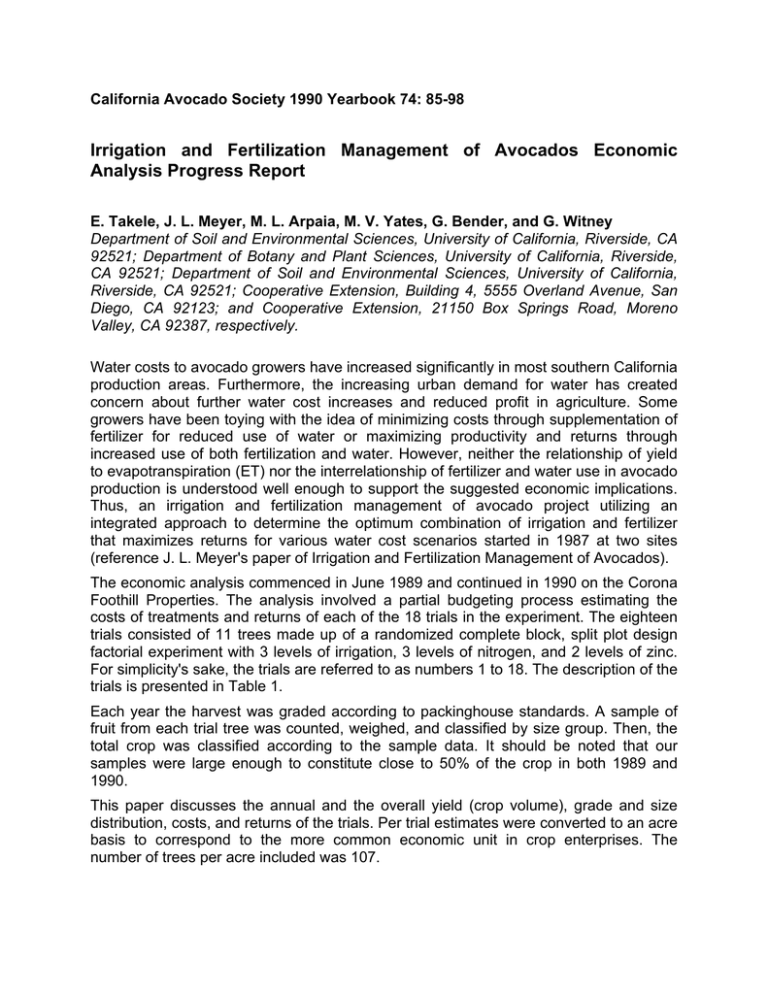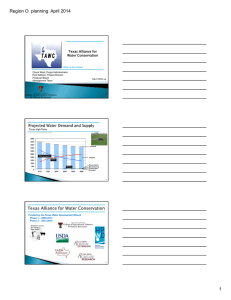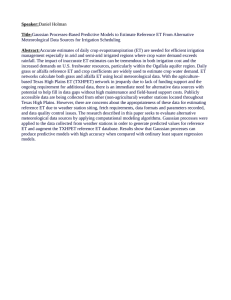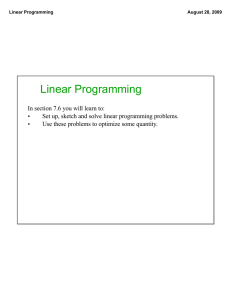Irrigation and Fertilization Management of Avocados Analysis Progress Report
advertisement

California Avocado Society 1990 Yearbook 74: 85-98 Irrigation and Fertilization Management of Avocados Economic Analysis Progress Report E. Takele, J. L. Meyer, M. L. Arpaia, M. V. Yates, G. Bender, and G. Witney Department of Soil and Environmental Sciences, University of California, Riverside, CA 92521; Department of Botany and Plant Sciences, University of California, Riverside, CA 92521; Department of Soil and Environmental Sciences, University of California, Riverside, CA 92521; Cooperative Extension, Building 4, 5555 Overland Avenue, San Diego, CA 92123; and Cooperative Extension, 21150 Box Springs Road, Moreno Valley, CA 92387, respectively. Water costs to avocado growers have increased significantly in most southern California production areas. Furthermore, the increasing urban demand for water has created concern about further water cost increases and reduced profit in agriculture. Some growers have been toying with the idea of minimizing costs through supplementation of fertilizer for reduced use of water or maximizing productivity and returns through increased use of both fertilization and water. However, neither the relationship of yield to evapotranspiration (ET) nor the interrelationship of fertilizer and water use in avocado production is understood well enough to support the suggested economic implications. Thus, an irrigation and fertilization management of avocado project utilizing an integrated approach to determine the optimum combination of irrigation and fertilizer that maximizes returns for various water cost scenarios started in 1987 at two sites (reference J. L. Meyer's paper of Irrigation and Fertilization Management of Avocados). The economic analysis commenced in June 1989 and continued in 1990 on the Corona Foothill Properties. The analysis involved a partial budgeting process estimating the costs of treatments and returns of each of the 18 trials in the experiment. The eighteen trials consisted of 11 trees made up of a randomized complete block, split plot design factorial experiment with 3 levels of irrigation, 3 levels of nitrogen, and 2 levels of zinc. For simplicity's sake, the trials are referred to as numbers 1 to 18. The description of the trials is presented in Table 1. Each year the harvest was graded according to packinghouse standards. A sample of fruit from each trial tree was counted, weighed, and classified by size group. Then, the total crop was classified according to the sample data. It should be noted that our samples were large enough to constitute close to 50% of the crop in both 1989 and 1990. This paper discusses the annual and the overall yield (crop volume), grade and size distribution, costs, and returns of the trials. Per trial estimates were converted to an acre basis to correspond to the more common economic unit in crop enterprises. The number of trees per acre included was 107. Yield (Crop Volume) The yield by trial since the 1988 season is given in Figure 1. The 1988 yield ranged from about 3,000 pounds per acre to the high of 12,000 pounds per acre. The lowest yielding trial was #16 and the highest was #15. It should be noted that a complete return analysis has not been done for 1988 due to lack of size distribution (packing data). In 1989 the lows switched to highs. Trial #9 brought the highest yield and trial #16 became one of the low yielding trials. However, 1989 had lower yield than 1988 as a whole. The range of yield was from a low of 800 pounds per acre to a high of 9,300 pounds per acre. The 1990 yield fell in between 1988 and 1989, ranging from about 3,300 pounds per acre to 9,300 pounds per acre. Trial #7 yielded the most and trial #12 the least. What we have observed is a tremendous variability in productivity among trials within a year, within trials from one year to the next, and among years. Because of the alternative bearing characteristic of avocados which implies that in any given year some trees will be naturally yielding well and some poorly, it will be difficult to distinguish the treatment effect in any single year. However, with data over several consecutive years, the differences effected by the alternate bearing characteristics on productivity will be minimized and the treatment effects will be expressed. The overall yield indicated that Trial #7 led in production based on both three year (1988 through 1990) data and two year (1989 and 1990) data. It averaged about 8,400 and 7,550 pounds per acre, respectively. The yield rankings of trials are provided in Table 2. Grade and Size Distribution Our packing process has not included #2s or standards. We learned from previous records that the emphasis has been on size rather than grade, thus very little of the crop has traditionally been classified #2s in the industry. Therefore, we did not concern ourselves in making grade distinctions. Figures 2 to 7 present the crop size distribution for both 1989 and 1990 seasons. An indirect relationship between crop volume and size of the crop has been observed. The 1989 crop, small in volume, leaned toward larger size. The bulk of the crop (56%) was sized 48s and above, with 48s alone constituting 41% of the crop. The 1990 crop, however, more in volume than the 1989 crop, was smaller in size with the bulk of the crop (70%) falling in the 60s and 70s categories. In both years, the proportion of the larger sizes increased with irrigation and nitrogen. Analysis of Costs and Returns The costs considered in this project were as follows: A. The material and application costs of water, nitrogen, and zinc. The amount of inputs (water, nitrogen, and zinc) applied to each treatment group can be determined from information given in Table 3. Annual prices of nitrogen and zinc were used; however, water costs vary depending on elevation. This study was based on water charge of $150/acre foot, the charge for a level slope (3%) orchard in Riverside-Corona area. Also included was interest on operating capital at 10%. B. Harvesting and marketing costs. These costs are functions of yield; therefore, they vary with the level of productivity. The harvesting charges of picking and hauling included the annual average of 6 and 2 cents per pound respectively. The marketing costs included packing at 7 cents per pound, and the California Avocado Commission (CAC) assessments were calculated at 4% of the gross returns minus harvesting costs. The gross returns for each trial were the sum of the product of the amount of fruit in each size category and the corresponding price. The 1989 returns were generally lower than the 1990 returns for two reasons: one, prices were lower in 1989; and two, the yield (crop volume) was smaller than for the 1990 season. The next procedure was to evaluate the impacts of costs on returns. The corresponding costs of each trial were deducted from the respective gross returns, and the remaining returns, referred to as partial net returns (PNR), were used as a basis for comparison among treatments. It should be noted that since this analysis is a partial cost analysis, the PNRs are subject to further deduction of other production costs. The PNRs of the eighteen trials both on an annual and on overall basis, are presented in Figure 8. Because gross returns are a factor of not only crop volume but also of the size distribution and the corresponding price variation, high yielding trials did not necessarily result in high returns. Furthermore, the variation of costs resulting from the variation of input application indicated some interesting results. For example, using the two-year average as a basis for comparison, it was found that Trial #9, which was second highest in yield, dropped to seventh place in returns. On the other hand, Trial #1, which was fourth in yield, rose to second place in returns. It is estimated that 74% of the drop in Trial #9 was affected by size distribution and the corresponding price variation, and 26% was due to costs. Comparison of the ranking of yield and returns is presented in Table 4. Once again, putting the two seasons (1989 and 1990) together, the PRNs indicated that Trial #7 was the leader by a wide margin (34%) over the second best Trial #1. Interestingly, both Trials #7 and #1 received no additional nitrogen and zinc, leaving water as the only variable for comparison, and consequently pointing to the issue of irrigation management. Increased productivity and returns were achieved as the level of irrigation increased from 80% ETc to 100% ETc. However, further increase of the irrigation level to 120% ETc did not result in improved productivity or returns. Therefore, the 100% ETc has been found to be the optimum level of irrigation using a $150 per acre-foot price of water. Will the optimum level of irrigation change with increase in price of water? This was evaluated by comparing the 80% ETc to the 100% ETc The marginal cost (the cost of the additional unit of water required to increase the ETc level from 80% to 100%) at increasing various prices of water was compared to the marginal value product (the increase in returns obtained as irrigation increased from 80 % ETc to 100 % ETc). The analysis is given in Table 5. The unit of increase is about one-third acre-foot of water. The cost of that unit of water at various water prices is given in column 6. The additional returns (the marginal value products) are given in column 7. The result shows that the marginal value product decreases with increases in prices of water. However, the marginal value product is such a large amount, it will take a tremendous increase in water prices before it falls below the marginal cost, at which point the 100% ETc will cease to be profitable and the 80% ETc becomes preferable. Tentative Conclusion The analysis showed that 100% ETc has been found to be the optimum level of irrigation. Furthermore, neither the substitution of fertilizer for reduced water use nor the combination of high level of water and fertilizer was found to maximize returns. However, because of the tremendous variability of the productivity of trees within the avocado grove from one year to the next, the conclusion should remain tentative until we get more data. We have one more year of funding left, but we are also requesting an extension by at least another year to 1992.




